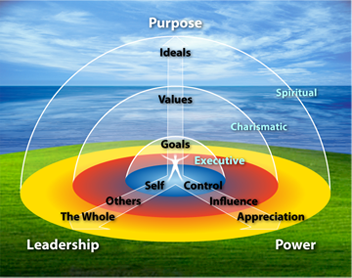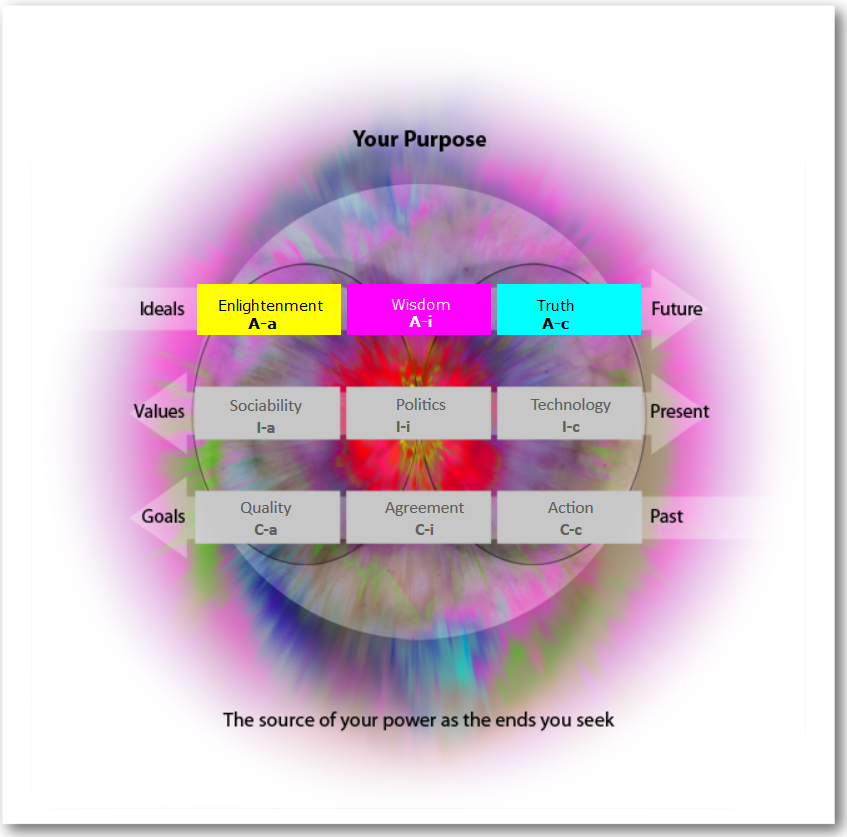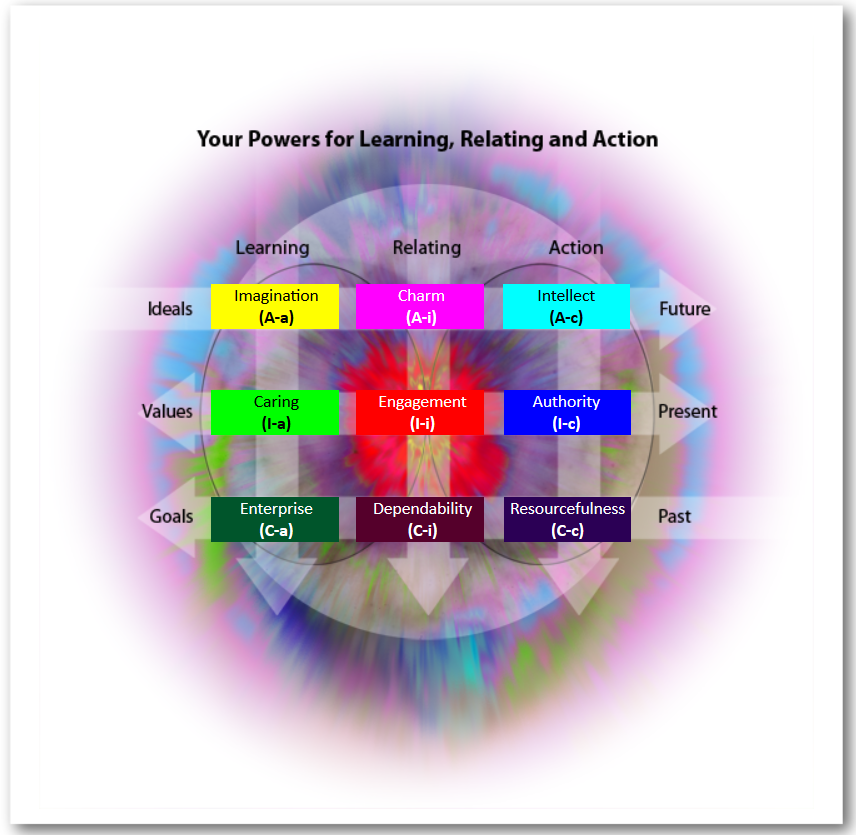
Report #

|
||


Your Purpose
Ideals
Ideals are our most open level of purpose so are also the most future-oriented of our purposes. They express our highest hopes and infuse everything else we do with meaning.
Your three ideals are the most appreciative possible.
- Enlightenment (A-a) gives you a capacity to grasp larger meanings. You seek to create a more understanding world open to all possibilities. You want to tackle the deepest challenges you encounter and unravel some of your world's greatest mysteries. This search makes you very open, highly perceptive and intuitive. This ideal and these qualities govern all levels of your purpose, ideals, values and goals.
- You enlist your ideal of wisdom (A-i), your capacity to balance meaning and understanding, to support and share with others your highest ideal. You want to help them understand and identity with your world in all its aspects. Your search exposes you to many non-traditional areas of knowledge and experience and gives you special access to the mystical. Your communication becomes subtle, creative and very much tailored to the audience.
- You guide implementation of your ideals through truth (A-c), your capacity to see and hold to the underlying principles. You create a very clear—even single-minded—vision of what is possible. You want to understand what others expect of you . You want to express your truth very openly, and to do so in a clear and orderly way. People will begin to see your approach as well reasoned, thorough and compelling.
Because our ideals can have such an impact on our life, on those around us and even on our world, they can be very dangerous. Nature, as represented through our subconscious image, recognizes this and through our basic instincts for survival and well-being gives us warnings.
- Your emphasis on enlightenment, for example, is likely to invoke feelings of disappointment when people sense the breadth of your purpose and the difficulty of bringing everything together to accomplish it.
- Your emphasis on wisdom, for example, may invoke a sense of revulsion in those who don't see the magic.
- Your emphasis on truth can produce a degree of aggression, for example, toward the lack of breadth or creativity in implementing your principles.
Our conscious mind can take such fears and exaggerate them preventing us from making progress with our ideals. In practice the way we can prevent these fears being exaggerated is through a deeper, more complete process of appreciation.

Values
Values are purposes that we share with others whom we cannot control. Values, then, create a field of influence beyond our field of control. The three values that most support your ideals are centered in the chart below.
The center row represents your present, one cycle, in which your three central values are at play. These values help you resolve the differences between your expectations for the future, while taking into account the kind of result you have had in the past. One value, sociability, links you to more openness—appreciation; one, technology, leads you to more closure—control; and one, politics, mediates between the two—influence.
- You use your core value—political(I-i), your desire to take others' interests into account—as your default mode for resolving differences between your ideals and the constraints of the realities you face. You have the courage to engage fully and energetically with others who have very different values. You bring a balanced approach which takes competing needs into account and welcomes opposition.
-
When you open toward appreciation, moving left on your chart, you tend to call on your social value (I-a)—your concern for others. It helps you to:
- Support you core value and remain open to new possibilities.
- Be open to engagement with others, who have different value perspectives, without giving up your own.
- Give of yourself in a very magnanimous way.
- When you want to move towards closure—to the right on your chart—your value for technology (I-c), your concern for functionality and precision, prevents you from over relying on your core and supportive values by focusing on more logical or strategic options. It helps you to bring greater personal conviction to the table in order to persuade those with doubts.
We have to recognize and accept that the sorting out of value differences is not the rational, logical, strategic planning process taught in our business schools but is a very emotional one. Different values produce different positive and negatives emotions, for example:
- If you continue your current course your core value—politics—you will feel either pride or arrogance, depending on how you sense others will react to continuing the present course and opening up the situation to more appreciation or closing it down towards control.
- If you open up to your value for sociability you will feel either fascination or annoyance depending on how you sense people will react to moving towards closure.
- Focusing on your technical value will likely invoke subconscious feelings of awe or dread, depending on how you feel others will respond to moving towards closure.
By improving our influence process we can allow such emotions to be aroused in a constructive way and let them play their natural role in getting values differences heard. The design of our influence process can help us better harmonize our differences while coming up with satisfactory resolutions good enough for this cycle.
The next phase of goal setting is designed to provide solutions rather than resolutions.
Goals
While our values invoke purpose that we share with others, our goals bring us home to our own individual purpose—whether we are an individual, a group, an organization or a community. Goals are our most closed and short-term form of purpose. Goals create our field of control which occupies the smallest space of the three fields but has the highest level of intensity, because it involves direct action right now.
We have goals that tell us not only what to focus on but also who to make working agreements with and how to learn from our experience.
- When implementing, i.e., giving form to your purpose, you focus on action (C-c). This perspective gives you confidence that you will carry out your commitments, you will achieve your goals and you can rely on others to do the same.
- You obtain support for this goal perspective through agreement— (C-i) obtaining joint commitments. This perspective allows you, for example, to use joint goal setting in coaching those you can't control in order to create working agreements with you. It can also make you appear very cautious, deliberate and thorough in the way you communicate your goals.
- Your emphasis in learning is quality (C-a). You like to see a solution in which everything fits together elegantly. You are quite assertive in commitment to your goals and thorough in appraising any conditions that could affect their achievement.
Ideals tend to produce negative subconscious reactions that warn us of dangers, and our values evoke both positive and negative emotions to help us sort out value differences. Our motives tend to produce subconscious positive reactions that encourage us to take action, e.g., pleasure, wealth, power. Sometimes our conscious mind acts on these motives when not totally appropriate to the situation and can lead to excesses that end up embarrassing us.
- Your emphasis on action (tasks) may be encouraged by your need for wealth, the satisfaction you get from acquiring and managing substantial resources.
- Your emphasis on agreement may be encouraged by your need for physical or emotional comfort.
- Your emphasis on quality may be encouraged by your need for pleasure—your need to relax, have fun and take things less seriously.
Improved design of your control process, as covered in your leadership section below, can help avoid exaggerated effects that might come from such motives.
Once you complete your process of learning in your field of control, you enter again into your field of influence with new in-flows from your experience; you receive new appreciations from others involved and continue the process. There is no beginning or end only a centering in your core value.
Your Power
Our power is our capacity to achieve our purposes. Every one of our purposes—from getting lunch to saving the world—has the same three fields of power:
- what we control relative to our purpose, e.g., our resources, our time and commitment
- what we can influence but not control, e.g., our relationship to other people and events beyond our control.
- what we appreciate, i.e., everything that affects our purpose but which we can neither control nor influence—peoples, ideals, culture, climate.
We all have different preferences for use of these powers and there is nothing good or bad in a particular preference. Your preference is unique in that it is the most appreciative possible-there is one chance in 3,628,00 (9 factorial) of having this profile.
- (A) Appreciation: You are future oriented and open-minded and accepting of others points of view You want to listen, learn and discover. You are willing to rely on your intuition to make decisions. You attract and are attracted by the spiritual, philosophical and intellectual. (53%)
- (I) Influence: You tend to live in the present. You rely a great deal on relationships. You are likely to rely on logic or feeling rather than intuition in selecting the means to accomplish your purpose. You relate to ideas, people and events in a dynamic way. You are attracted by the give and take of both collaboration and competition. (33%)
- (C) Control: You rely a great deal on experience. You can be independent but also know how to manage a partnership. You pay attention to the practical quality of life. You like things to be certain and predictable. (13%)
Your Preference for Means to Exercise Your Power
The power we describe above is the power we project onto others and our world in order to achieve the ends we seek. We code this kind of power as large (A), (I) and (C). However, our power is a relationship between ourselves, others and our world. So the power of (A), (I) and (C) takes account of only half of the power relationship. It does not reflect the power that others have over us. Our subconscious image of our world contains within it much experience that tells us how others might react when we try to control, influence or appreciate them. The practical outcome of this understanding is our choice of means we choose to exercise our power.
We can characterize any means as appreciative, influence or control:
- (a) appreciative—those means we use to keep us open for learning
- (i) influence—those we use for relating to ideas, people
- (c) control—those we use for action, managing our resources
Each of us has a different preference for use of means.Your unique profile as well as giving you the highest possible preference for appreciative ends also gives you the highest possible preference for appreciative means.
So, the power we use in any situation is a combination of the power we project onto our world [our ends (A), (I) or C)] and the power we use to implement those ends [our means (a), (i) or (c)]. For example, a scientist must be very open in order to discover new phenomena and make new theories and models built on them, so she projects appreciative power (A) onto her world. However, she knows that people will not accept her discoveries, theories and models unless they can be verified—unless they work. That is, the scientist has to choose control means—specific and measurable—to be credible in her scientific world. Her power then is (A-c) an appreciative end with control means.
We have nine such combinations. These nine cover the entire spectrum of possible powers, from the most open, (A-a) appreciative ends and means—the lightest color, yellow—to the most closed, (C-c)—the darkest color, indigo.Your unique profile follows this pattern exactly , from the most appreciative to the most controlling.

Your preference for means (a), (i) and (c) is read vertically down each column.
The first column lists the powers you prefer to use for learning:
- Imagination (A-a): openness and originality
- Caring (I-a): compassion and concern for people and their well-being
- Enterprise (C-a): initiative and practical creativity
The second column lists, in order of priority, the means you use to better relate to your world of ideas, people and resources:
- Charm (A-i): ability to fscinate, delight and communicate diplomatically
- Engagement (I-i): capacity to engage strongly
- Dependability (C-i): trustworthiness and reliable supportiveness
The third column lists, in order of priority, the means you choose to bring things to closure or action:
- Intellect (A-c): intelligence and reliance on principles
- Authority (I-c): knowledge and strong sense of direction and priorities
- Resourcefulness (C-c): ingenuity and ability to find different relevant ways
Whereas, for all practical purposes, we take our preference for ends as given by our nature, this is not as true for our preference for means. Our choice of means is more open to our own appreciation, influence and control.
- Through appreciation we can close the gap between how we believe the world reacts to us and how it actually does.
- Through influence we can become more engaged to evoke both new possibilities as well as to get more closure through our engagements.
- Through control we can develop the support systems, practices and discipline to ensure that we will use appreciative, influence and control means equally.
One of the most practical implications that we can take away from our maps is that we can have most impact on the pursuit of our purpose and our use of power by using appreciative influence and control means equally for any purpose. With your unique profile you accomplish this balancing naturally you have an (a), (i) and (c) in every row.
Your Situational Power
Our power, then, is a two-way street: (1) what we project onto our world and (2) what the world pushes back at us. What our world pushes back at us influences our choice of means. In practice, this push back comes from situational demands. The following shows how we react to power when we are in situations that require us to control, influence or appreciate, and things go well—or not so well.(Control Space) Situations Requiring Closure
- In situations which demand control, you operate by establishing the premises with which to understand the situation. You identify the principles involved. You attempt to get at the truth behind the issues.
- When you are not able to establish this level of control, you feel that you have to make the best of it even if you are not succeeding.
(Influence Space) When Sorting out Differences
- In such dynamic situations you charm, fascinate and attract others to you. You generate an infectious enthusiasm for what you are undertaking.
- When you sense you may not be as successful as you hoped, you feel you should give up but fear that to do so would seen as weakness. You become concerned bout your security but continue to resist.
(Appreciative Space) Reflecting on Your World
- At this stage of your life, you feel somewhat restless in your spiritual search. You seek ever outward for something more enlightening, more perfect. You use your power to understand the future and create new possibilities. In your search you are ever hopeful, optimistic and unselfish.
- When you feel things are not going well, you begin to lose your commitment. You feel that people around you are not up to the mark. You continue to go through the motions but know that you are not getting anywhere.
Summary of Your Power
The power you project onto your world through the ends you seek is (A) - appreciation.You emphasis on appreciative power gives you special insight into the future, which in turn colors everything you think and do. You use your intuitive insight to see possibilities beyond the current conditions that drive your world. This gift is a blessing in that it helps you to attain the kind of creative insight that can change your world. It can, however, be a curse in that others don't necessarily want their world changed. So success for you will entail learning to communicate your insights in safe places and in diplomatic ways. That you are generally seen as kind and thoughtful with others will help you in this.- How you get things done is influenced by others (a) appreciation means.You prefer appreciative means that help you listen, learn and reflect before you act. You can be quite imaginative, creative and original. You can put great emphasis on diplomacy in communicating your ideas. You also show great powers of concentration. People may see you as somewhat quiet—but bright—and may have difficulty understanding some of your best ideas.
- How you resolve differences (I-i) You use your core value—political, your desire to take others' interests into account—as your default mode for resolving differences between your ideals and the constraints of the realities you face. You have the courage to engage fully and energetically with others who have very different values. You bring a balanced approach which takes competing needs into account and welcomes opposition.
The chart below summarizes both perspectives.
Our power oscillates around our core value, our center of power. It flows upward to what we appreciate—our ideals, our desired future—and flows downward, leading to the means we choose to realize our future.
How we manage this process, from purpose to power and then realization, determines how we lead our lives. It is this concept of leading our lives—integrating our relationship to ourselves, others and our world—that provides the basis for our pattern of Leadership.
Our Introductory Map showed us how the concept of power is linked to leadership. We can also see how both the concept of power and the concept of leadership have evolved in the same direction.
- We began seeing leaders as individuals who had the skills necessary to exercise power over others—a control perspective.
- We progressed by adding a more open, democratic and situational view of leadership. Leadership arose out of a situation or group and exercised power with others, an influence perspective.
- A new view is emerging in which leadership is a function that we can all perform by linking our unique capacities to those of others and our world. Collectively "we the people" can produce a transformational power to create higher levels of purpose and, hence, powers not harnessed before. Such leadership can create cultures which transcends the power of the individual or group.
We see our leadership, as shown in our chart, as a power relationship that links ourselves to others and our world. This power relationship has two flows:
- The first power flows from us to others and our world. It is our more natural leadership style and derives from the ends we pursue. It is the large (A), (I) and (C) in our charts.
- The second power flows backwards from our world through others to ourselves. it defines the part of our leadership style learned through experience, and it is expressed as the small (a), (i) and (c) in our charts. It derives, you will recall, from the influence of our subconscious image of our world which anticipates how people will react to us, so influences our choice of means.
Your Leadership
Your Natural Leadership Style
The first flow, your natural style—which you can appreciate but have very little influence or control over—gives the following emphasis:
- Your primary style is becoming more spiritual. You are putting relatively more effort into understanding your world and the latencies it reveals. For example, you are learning to use your appreciative powers—which will enable you to better discover new possibilities, give them meaning and communicate them diplomatically. The relative emphasis you give to these leadership powers is 53 %.
- Your secondary style is more charismatic. You currently rely more on your influence powers, engaging with others to evaluate and negotiate resolution to issues. The relative emphasis you give to these leadership powers is 33 %.
- You rely least on a pragmatic style of leadership. You pay relatively less attention to your powers of control—to lead through direction, to make working agreements and to monitor actions in practical ways. The relative emphasis you give to these leadership powers is 13 %.
Your Learned Leadership Style
Your second flow, from your world to you, gives your learned style of leadership. It is based on your preference for means. You have more influence and control over this part of your leadership pattern. If you prefer appreciative means, we label this the style of the guru. If your prefer influence means we give the label politician. If you prefer control means we refer to the style of the executive.
Each of us has a different preference for use of means.Your unique profile as well as giving you the highest possible preference for appreciative ends also gives you the highest possible preference for appreciative means.
- Your first preference, for appreciative means (53 %), gives you a primary leadership style of guru—in which you give special attention to knowledge, contributing especially to policy and strategy discussions.
- Your second preference, for influence means (33 %), gives you a secondary supportive style of politician—in which you give special attention to relationships by engaging negotiating, creating agreements and developing trust.
- Your last preference, for control means (13 %), gives you your least preferred style of executive—in which you give special attention to resources whether they are ideas, relationships or things. You seek to create more certainty and gain closure.
When you combine your leadership emphasis on appreciative ends and appreciative means, your overall style becomes that closest to a Spiritual Guru(A-a). You can check how close you come by examining the chart that shows all nine patterns.
The chart shows that each of the types has a color that expresses the essence of the contribution of that Leadership type. As a spiritual guru, the color yellow best expresses the imaginative power to see beyond the present. You create a climate of respect in which people can both transcend current difficulties and discover new more enlightened paths.
Augmenting your Leadership Powers
As with purpose and power your job is not to change your basic leadership emphasis from spiritual to charismatic or pragmatic but to understand how you can use these styles most effectively. You should now have a fair appreciation of what those powers are and how they give you the capacity to enact your ideals, values and goals.
You should also take comfort in that your natural leadership powers do represent who you are and need no change by yourself or for anyone else. You can free yourself to deal with those means you influence and control that will help you augment your power to achieve your purposes in a way that supports others and the common good.
- It is through appreciation that we connect to our world and its infinite possibilities through our ideals from enlightenment to equanimity.
- It is through influence that we join with other interested parties and sort out our differences of value from spiritual to economic.
- It is through control of ourselves that we make decisions and get things done form discovery to action.